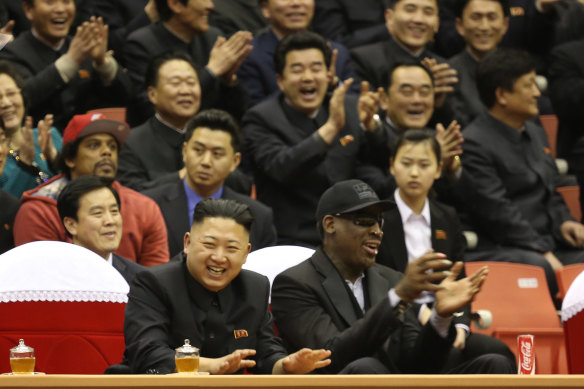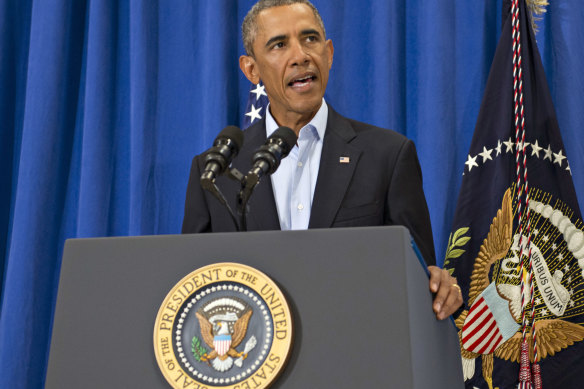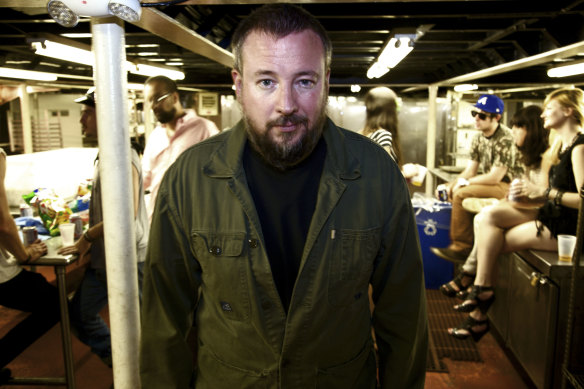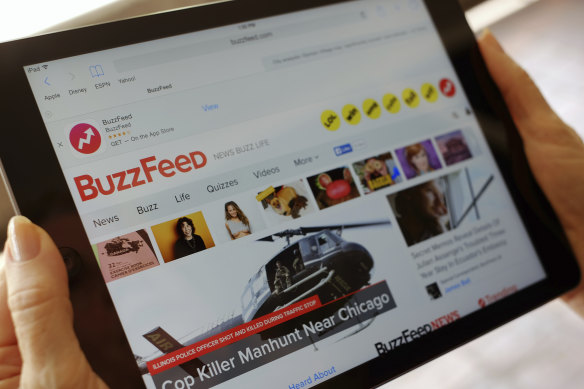[ad_1]
The publisher built a brand through its edgy coverage of drugs, sex, and war zones.
Despite a traditional aversion to these sorts of topics, some investors and advertisers threw money at the company because of Vice’s ability to reach Millennials.

Vice filmed basketball star Dennis Rodman travelling to North Korea for an exhibition game, culminating in a meeting with dictator Kim Jong-un.Credit: AP
The company rode a wave of investment and grew rapidly, establishing its own broadcast news channel, film studio, ad agency and record label.
But as the digital ad market went into decline, and as new platforms such as TikTok have emerged, the online publisher has plunged into a death spiral.
Advertisers have lost interest and clean-living Generation Z audiences have not clicked with its gaudy content.
Last week, Vice shut down its World News brand and announced dozens of “painful but necessary” job cuts. Now, it is reportedly preparing to file for bankruptcy, according to The New York Times.
Vice grew out of a punk magazine in 1990s Montreal before transforming into a sprawling, youth-focused media empire.
Its popularity was in large part due to its willingness to push boundaries, publishing stories that mainstream publishers were too afraid or squeamish to touch.
In an interview soon after launching in the UK, then editor Andy Capper said Vice’s remit was to celebrate “the things we’re meant to be ashamed of”.
Loading
More often than not, this involved sex, drugs and bodily functions.
The online publisher sent its journalists out on elaborate, Gonzo-style reporting trips, producing eccentric films such as The Cannibal Warlords of Liberia, where reporters interviewed rebel leaders in the West African country, and Pharmacopeia, a TV series studying psychoactive drugs fronted by filmmaker Hamilton Morris.
Smith hosted rowdy launch parties around the world as the company expanded and handed out wads of cash to staff at a Christmas party.
As with its digital media rival BuzzFeed, Vice tried to broaden its appeal with more serious journalism as it grew, landing an interview with former president Barack Obama and publishing earnest dispatches on topics including the London riots.
In 2013, Vice made headlines when it filmed basketball star Dennis Rodman travelling to North Korea for an exhibition game, culminating in a meeting with dictator Kim Jong-un.

Vice tried to cultivate an image as serious journalists by landing an interview with former US president Barack Obama.Credit: Getty
The journalistic merits of the trip were hotly debated, with some dismissing it as a softball stunt.
In an interview in 2013, UK editor Alex Miller said: “I think traditionally we have been associated with staying up late and making a lot of noise. Maybe we’ve grown up, or maybe the world’s changed to such a degree that we can’t ignore it.
“But the things that get our attention now are more serious than just sex, drugs and rock ‘n’ roll.”
With this newfound maturity came investment from backers including Disney, Fox and WPP.
Loading
According to a New York Times report, Disney considered buying Vice in 2015 at a valuation of more than $US3 billion. At its peak two years later, the media group was worth $US5.7 billion.
But Vice’s time in the sun was ultimately short-lived. After reaching its peak valuation in 2017, it entered a period of long and painful decline.
Vice’s troubles lay in its reliance on building large audiences through social media and its reliance on advertising.
It struggled after Facebook shifted away from offering media companies a fire hose of traffic. In recent years, the digital ad boom has also come to an abrupt end.
“Both Vice and BuzzFeed thrived because they were the cool, new brands of their era. Now brand fandom has fragmented.”
Mark Mulligan, Midia Research
While Vice diversified into other revenue sources, including lucrative deals to create sponsored content, it has struggled to turn this into a viable business while still maintaining its traditional audience.
Vice’s bet on cable TV also proved poorly timed, as streaming services quickly took over as the dominant force. The company struggled for years to turn a profit and has been forced to make a number of rounds of layoffs.
Mark Mulligan, managing director of Midia Research, says: “Vice and BuzzFeed arose as next generation media companies when the internet started to transform media. They came at things with a fresh, digitally native approach that enabled them to quickly steal market share from traditional media.
“But just like Yahoo, MSN and AOL had done the same in the early days of the web but struggled for relevance when the next chapter came, Vice and BuzzFeed have struggled to thrive in a digital media world that is now dominated by social and streaming.”

Vice Media co-founder Shane Smith.Credit: New York Times
The recent rise in interest rates has made it harder to attract funding and proved to be the final nail in the coffin for some. BuzzFeed recently shut down its news operation, while rival Insider made 10 per cent of its US workforce redundant as the digital media downturn spread through the industry.
Ultimately, the downturn proved too much for Vice. The start-up collapsed into bankruptcy in May last year owing creditors as much as $US1 billion. It was bought out by a consortium of investors including George Soros and Fortress Investment Group.
Now, the new owners have effectively stripped the media company down to its brand. Vice will shut its own website and instead focus on selling articles and videos, including news, to established media brands.
Chief executive Bruce Dixon warned hundreds of jobs would be lost in the move to a so-called “studio model”.
“Ultimately, both Vice and BuzzFeed thrived because they were the cool, new brands of their era,” says Mulligan.
“Now brand fandom has fragmented and mainly happens in places where audience engagement is decentralised – especially social media – and it has proven much harder for them to build and maintain cultural relevance in those often unforgiving and short attention span environments.”
Teasdale at Enders Analysis says: “Companies like Buzzfeed and Vice were once thought to be the future of news … As long as they were growing readership and generating buzz, investors were willing to throw money at them, but the reality is they never figured out a sustainable business model.”
Many traditional media companies have embraced a move to subscriptions, reducing their reliance on advertising by building up loyal audiences.

Vice’s biggest competitor BuzzFeed.Credit: AP
“The best options right now seem to be finding an audience who are willing to pay, or attracting such a valuable demographic that advertisers will spend big to reach them, but it’s a struggle even then,” Teasdale says.
Some smaller players such as Politico have enjoyed modest success by targeting a valuable business or political readership and marrying an ad-funded model with subscription tiers. Politico also benefits from the safety net of a big backer in German media giant Axel Springer.
Axios, another media startup, has created waves with its short, blog-like format, a style it dubs “smart brevity”.
The demise of Vice and its digital media contemporaries means investors may think again before pumping vast sums of money into the sector. Smith, who once referred to himself as the “Stalin of Vice”, is unlikely to suffer personally from the company’s demise.
The founder declared he had become “post-economic” after selling $US100 million of shares back in 2014, Semafor reported. Smith also sold his Santa Monica estate for almost $US50 million, doubling his investment.
The Telegraph, London
The Business Briefing newsletter delivers major stories, exclusive coverage and expert opinion. Sign up to get it every weekday morning.
[ad_2]
Source link


